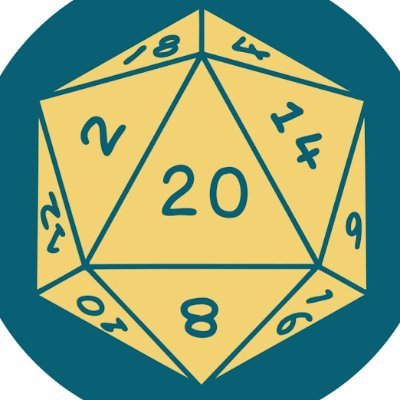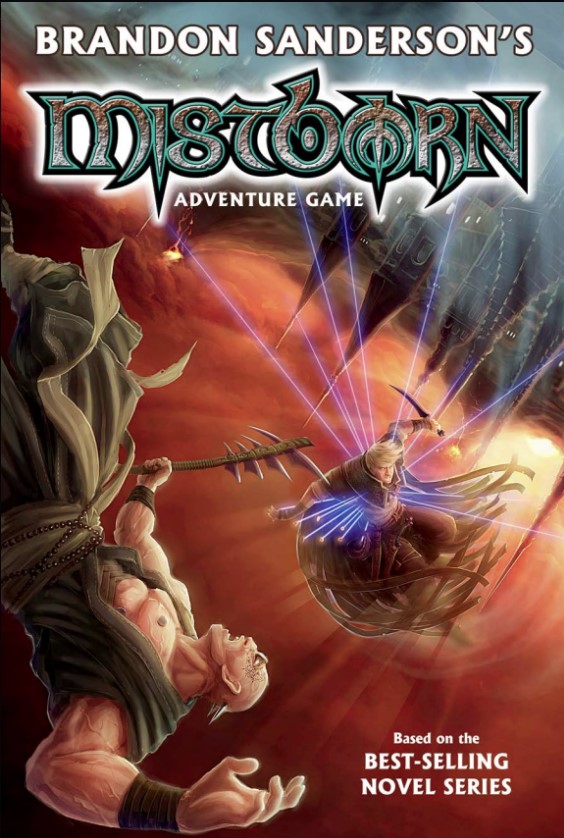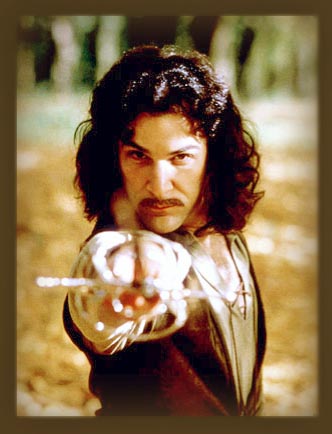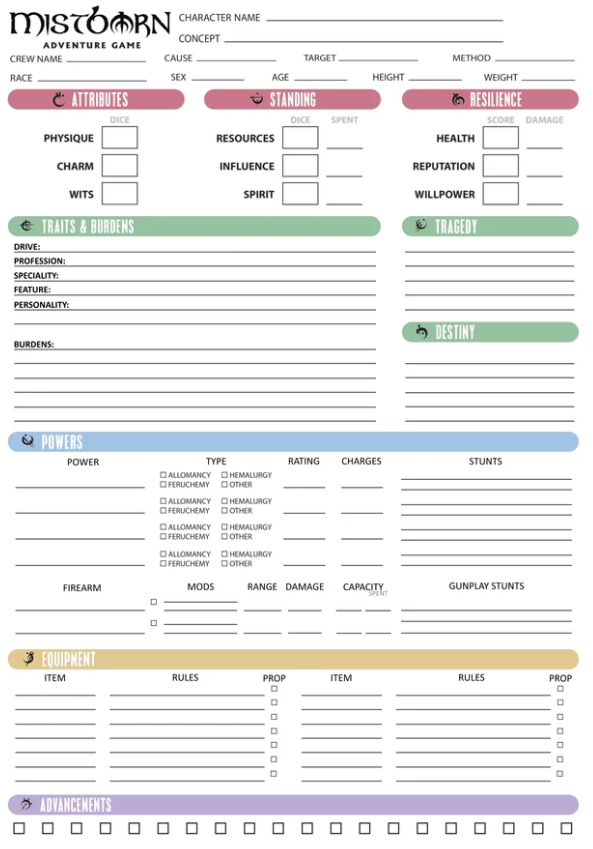


Overview
The Mistborn Adventure Game by Crafty games is a roleplaying game based on the Mistborn fantasy book series. The design of the core RPG seeks to allow you to play characters inspired by those from the trilogy in a campaign setting based on the first book. While you certainly can play in later settings, the game is best as a heist game, where you are part of a crew attempting a seemingly impossible mission.
- Heist
- The core game is about a crew attempting a seemingly impossible heist in a broken world. The game drives towards an agreed-upon group goal, such as stealing a powerful weapon, robbing a rich and resourceful noble, or uncovering a well-guarded dark secret.
- Theatre of Mind
- The game is designed for optimal play in theater of the mind. However, the declaration of actions, free-form nature of nudges and called-shots, and utility that can come from your equipment and powers all lend a tactical variety to combat, sneaking, debate, and more.

Resolution Mechanic
Whenever you make a roll, you form a dice pool between 2 and 10 d6. You select the Attribute, Standing or Power that makes the most sense given the action you are trying to perform and add that many dice to the pool.Then you (or the GM) can declare any traits (yours or your opponent’s) that affect your roll. Add one die to your pool for each trait that supports the action and subtract one die for each trait that is detrimental. If you have a tool that helps you (but is not necessary), you may add one more die to the pool and if you’re lacking an important tool or are using a necessary tool that is damaged or broken, you may have your pool shrink by one die.
Of course, circumstances may also improve your conditions. Generally, if you can name two or more favorable conditions, your pool goes up one die, if you have two or more adverse conditions, it shrinks. This may sound like a lot, but it usually goes quite quickly at the table.
Once you have your pool of dice, you decide how many to roll. When you have no need to defend yourself, the answer is usually “all of them,” but if you may need to defend against an attacker (physical or verbal) you may want to withhold some dice for your defense. Results can range from 1-5. When you roll, you find the highest double and that is your result. 6s, however, are special. They’re called “nudges” and can be used to make a success better or a failure less horrible. For example, if I roll 6 dice on an attack and get 3s and a nudge against my opponent’s 2s, I could use my nudge to deal an extra damage or refund one of my dice for use in defense. There are all sorts of other uses for nudges. For example, if you want to make a called shot, say to knock an item off your opponent’s belt or inflict a particular wound, you simply make the same roll, but if you don’t get at least two nudges, the attack fails completely. This rule can be used for trip or push attacks tooCharacter Design
Attributes
Each character is created using 3 sets of 3 scores (9 total). You have 3 attributes: Physique, Charm, and Wits, 3 Standings: Resources, Influence, and Spirit, and 3 Resiliences: Health, Reputation, and Willpower. Each Attribute and Standing represents the dice you roll when you take an action that is uncertain where the outcome is dramatic. Your Resiliences are created by adding an attribute and standing together: Physique+Resources=Health, Charm+Wits=Reputation, and Wits+Spirit=Willpower. Each is a separate pool of “health.” Usually, your Health is targeted during combat, your Reputation during public debate, and your Willpower during negotiation or other tests of the mind.
Skills
Each character gets traits that make their character unique. These can be skills, such as metalworking, personality quirks, or physical traits. Traits are relatively neutral things that can be used both in your favor and against you. However, your traits should support your character concept and so will most often be used in your favor.
Abilities/Power/Feats
Additionally, each character may have special powers. These powers may allow them to draw from a limited pool of extra dice when they make a roll or it may be a unique ability a normal human can’t perform, in which case you might roll the power instead of an attribute or standing.
Equipment / Gear
You have a number of "props" or important equipment equal to your Resources. Props can be shared between players, so rich characters with poor attributes can equip powerful, but poorer characters if they wish. Additionally, you can attempt to purchase items during a session by rolling Resources against that item's difficulty.
Advancement
The game encourages you to make a thieving crew that are all working together on a goal, and ties advancements to your personal or crew goals. The game is pretty freeform and allows you to spend some number of advancements to do anything from gaining a trait or improving a stat to gaining new powers.
Combat
Attack Mechanic
During any conflict (and the game makes no assumption you will be in physical conflict more or less than mental or social) each player has an action and a reaction. Each player declares their intended action from lowest wits to highest wits. So the better your wits, the more information you get before you have to make a decision. Then actions are resolved in order from the most action dice to the least action dice. When you take your action, you choose how many dice from your pool you want to spend on it, and the rest are retained for your reaction.
I’ve found this system quite engaging and flexible. A story often naturally falls out as each enemy and player describes their action. An enemy launches an arrow at a PC, who uses a power to redirect it into a fleeing guard they otherwise couldn't reach. A muscled brute of a man lumbers toward the scribe who lets out a squawk and scrambles backwards to slam the door between them. The muscled man has to pause, but only for a moment as he smashes through the door instead of the scribe... for now
Resource Management
Character Sheet

